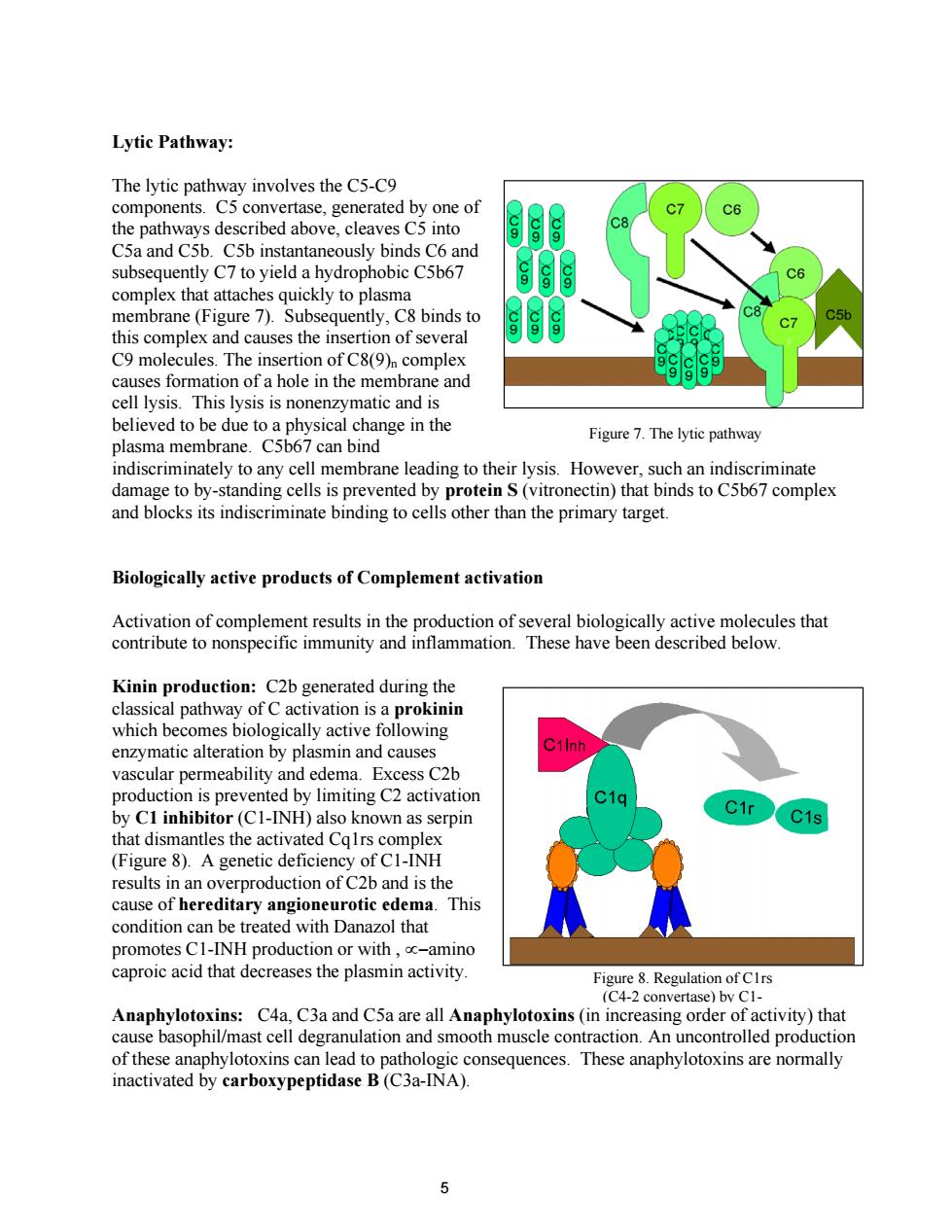正在加载图片...

LyticPathway: The lytic pathway involves the C5-C9 components.C5 convertase,generated by one of the pathways described above,cleaves C5 into C5a and C5b.C5b instantaneously binds C6 and subsequently C7 to yield a hydrophobic C5b67 complex that attaches quickly to plasma membrane(Figure 7).Subseque ntly.C8 binds to nd ofs C9 mo The inser of C8(9 comple hole in the e llysis lysis is believed to be due to a physical change in the plasma membrane.C5b67 can bind Figure 7.The lytic pathway indiscriminately to any cell membrane leading to their lysis.However,such an indiscriminate damage to by-standing cells is prevented by protein S(vitronectin)that binds to C5b67 complex and blocks its indiscriminate binding to cells other than the primary target. Biologically active products of Complement activation Activation of co ple, of se contribute to nonspecific immunity and active oc that below. Kinin production:C2b generated during the classical pathway of c activation is a prokinin which becomes biologically active following enzymatic alteration by plasmin and causes vascular permeability and edema.Excess C2b production is prevented by limiting C2 activation by C1 inhibitor (C1-INH)also known as serpin hat dismantles the activated calr re 8).A gene etic defici OCL-INH es in nd is the rotic ede h condition can be treated with Danazol that promotes Cl-INH production or with,c-amino caproic acid that decreases the plasmin activity. Figure 8.Regu Anaphylotoxins:C4a.C3a and C5a are all Anaphylotoxins(in increasing order of activity)that cause basophil/mast cell degranulation and smooth muscle contraction.an uncontrolled production of these ans aphylotoxins can lead to pathologic con sequences.These anaphylotoxins are normally inactivated by carboxypeptidase B(C3a-INA).Lytic Pathway: The lytic pathway involves the C5-C9 components. C5 convertase, generated by one of the pathways described above, cleaves C5 into C5a and C5b. C5b instantaneously binds C6 and subsequently C7 to yield a hydrophobic C5b67 complex that attaches quickly to plasma membrane (Figure 7). Subsequently, C8 binds to this complex and causes the insertion of several C9 molecules. The insertion of C8(9)n complex causes formation of a hole in the membrane and cell lysis. This lysis is nonenzymatic and is believed to be due to a physical change in the plasma membrane. C5b67 can bind indiscriminately to any cell membrane leading to their lysis. However, such an indiscriminate damage to by-standing cells is prevented by protein S (vitronectin) that binds to C5b67 complex and blocks its indiscriminate binding to cells other than the primary target. Figure 7. The lytic pathway Biologically active products of Complement activation Activation of complement results in the production of several biologically active molecules that contribute to nonspecific immunity and inflammation. These have been described below. Kinin production: C2b generated during the classical pathway of C activation is a prokinin which becomes biologically active following enzymatic alteration by plasmin and causes vascular permeability and edema. Excess C2b production is prevented by limiting C2 activation by C1 inhibitor (C1-INH) also known as serpin that dismantles the activated Cq1rs complex (Figure 8). A genetic deficiency of C1-INH results in an overproduction of C2b and is the cause of hereditary angioneurotic edema. This condition can be treated with Danazol that promotes C1-INH production or with , ∝−amino caproic acid that decreases the plasmin activity. Anaphylotoxins: C4a, C3a and C5a are all Anaphylotoxins (in increasing order of activity) that cause basophil/mast cell degranulation and smooth muscle contraction. An uncontrolled production of these anaphylotoxins can lead to pathologic consequences. These anaphylotoxins are normally inactivated by carboxypeptidase B (C3a-INA). Figure 8. Regulation of C1rs (C4-2 convertase) by C1- 5